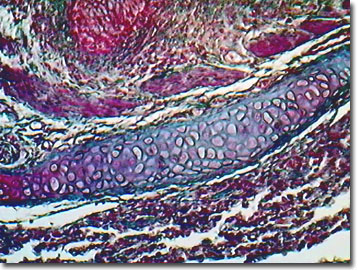Brightfield Digital Image Gallery
Human Lung Tissue
The lungs are the essential organs of mammalian respiration. Human lungs are paired in the chest with the heart in between. The external surface of a lung is smooth and conforms to the shape and size of the thoracic cavity or chest, bounded by the rib cage in front and back, and below by the movable diaphragm.

Inspiration, or breathing of air rich in oxygen, is achieved through enlarging the chest by contracting the diaphragm, and thereby, reducing the external pressure on the lungs, allowing them to expand. This creates suction, taking in the fresh air. Expelling oxygen-depleted air, rich in carbon dioxide, is achieved as the diaphragm returns to its resting place and the thoracic cavity is shortened, adding external pressure to the paired lungs and squeezing air out of them.
The respiratory system of the lungs branches similarly to a tree, with about 17 levels of branching between the trachea and the bronchioles, and terminates in about 130,000 bronchioles in the average pair of human lungs. The inner portion of the lungs is the site of the actual gas exchange between the blood and the external environment. Capillaries allow simple diffusion around small pocket cells (or alveoli), which increase the surface area of the lungs to about 50 to 100 square meters, with a typical four-liter volume. Carbon dioxide-rich blood arrives by the pulmonary veins and enters the alveolar capillaries. When the waste carbon dioxide is released, the hemoglobin in the red blood cells becomes available to bind oxygen from the fresh air taken in via the nose and mouth.
Lung diseases in humans include cancers caused by cigarette smoke and asbestos as well as asthma, bronchitis, pneumonia, and Legionnaire's disease. When air containing cigarette smoke or asbestos is inhaled, irritating particles of carcinogens such as tar or asbestos fibers lodge in the lung tissue and may result in the formation of cancer cells, depending on other environmental and genetic factors. Lung transplants are performed on some with diseases, and the promise of lung tissue culture using human stem cells may hold hope for others.
Contributing Authors
Cynthia D. Kelly, Thomas J. Fellers and Michael W. Davidson - National High Magnetic Field Laboratory, 1800 East Paul Dirac Dr., The Florida State University, Tallahassee, Florida, 32310.
BACK TO THE BRIGHTFIELD IMAGE GALLERY
BACK TO THE DIGITAL IMAGE GALLERIES
Questions or comments? Send us an email.
© 1995-2025 by Michael W. Davidson and The Florida State University. All Rights Reserved. No images, graphics, software, scripts, or applets may be reproduced or used in any manner without permission from the copyright holders. Use of this website means you agree to all of the Legal Terms and Conditions set forth by the owners.
This website is maintained by our
Graphics & Web Programming Team
in collaboration with Optical Microscopy at the
National High Magnetic Field Laboratory.
Last Modification Friday, Nov 13, 2015 at 01:19 PM
Access Count Since September 17, 2002: 15267
Visit the website of our partner in introductory microscopy education:
|
|
